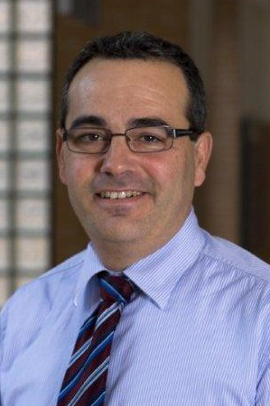Electronics and ionics for energy devices

He conducts researches on several aspects of materials and interfaces for energy conversion and storage. Mechanisms at the Nanoscale have fostered cutting age investigations in a wide variety of electrical devices. Organic and molecular functional semiconductors used in thin film transistors, photovoltaic cells and light-emitting diodes exhibit a high degree of charge localization confining relevant operating processes as transport and recombination within the Nanoscale. Interfaces and interlayers of nanometer size at device contacts play a central role in establishing contact energy level alignment and charge transfer injection and extraction in optoelectronic devices and sensors. Nanosize-related phenomena in energy storage materials are a key issue orienting current research in higher capacity and cycling performance of batteries. Also hybrid perovskite materials have appeared recently as highly potential light absorbers with interesting physical properties. This research program focuses on understanding connections between structural, thermodynamic, and kinetic aspects, and electrical behavior and new functionalities of novel materials and interfaces. We are particularly interested in the nano-effects incorporated into complete electrical devices for optoelectronics, photovoltaics, energy storage, and sensoring. Particularly relevant for our research is parameter extraction and mechanism identification inferred from impedance spectroscopy analysis.
Short Biography of Prof. Garcia-Belmonte
Germà Garcia-Belmonte (1964) received his Ph.D. degree at UNED, 1996. He worked (1988-1992) at CIEMAT, Madrid, on experimental and theoretical research in the area of digital processing of nuclear signal. He joined the Universitat Jaume I, Castelló, in 1992 and currently works as a Full Professor of Applied Physics (2010) at the Institute of Advanced Materials. He published 188 papers in research journals, and has 10.000 citations and h-index 50 (WOS). He studied intercalation processes in oxides and polymer films by impedance methods. He follows researches in various areas within the field of Organic Electronics and photovoltaics as electronic mechanisms in organic light-emitting diodes, organic photovoltaics, and plastic and thin-film solar cells. He is currently conducting researches in the topic of perovskite-based solar cells. Also of interest is the electrochemical kinetics of electrodes for batteries. Device physics using impedance spectroscopy (including modeling and measuring) is his main subject.
Publications
2006
-
IEEE Transactions on Dielectrics and Electrical Insulation,
2006,
An explanation of the peculiar behavior of TSDC peaks at Tg: a simple model of entropy relaxation.
Article page:
-
Physica Status Solidi (a),
2006,
203,
3762-3767.
Thickness scaling of space-charge-limited currents in organic layers with field- or density-dependent mobility.
Article page:
-
Synthetic Metals,
2006,
156,
944-948.
Determination of Electron and Hole Energy Levels in Mesoporous Nanocrystalline TiO2 Solid-State Dye Solar Cell.
Article page:
-
Journal of Applied Physics,
2006,
100,
103705.
Determination of spatial charge separation of diffusing electrons by transient photovoltage measurements.
Article page:
-
Journal of Applied Physics,
2006,
100,
84502.
Impedance of space-charge-limited currents in organic light-emitting diodes with double-injection and strong recombination.
Article page:






